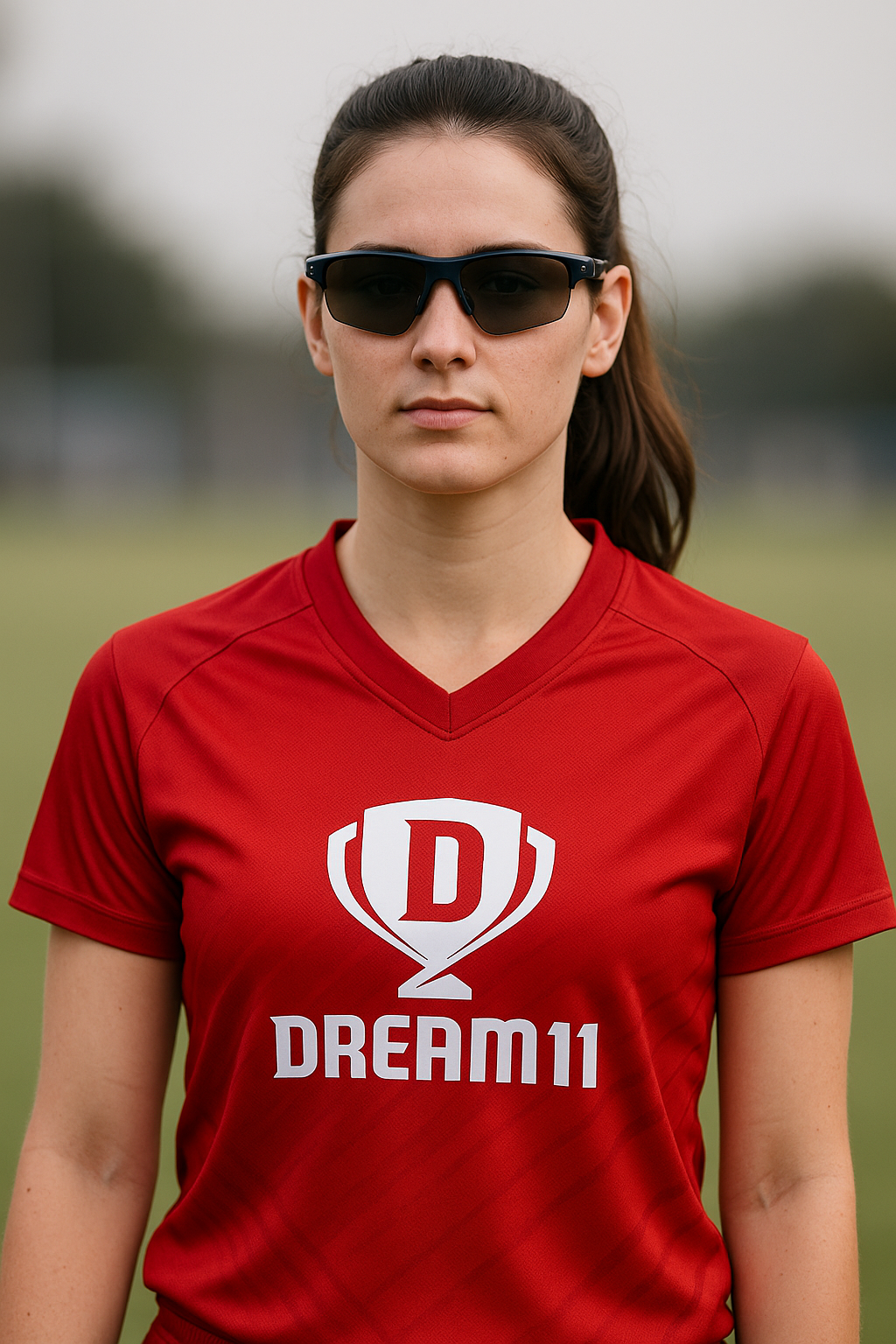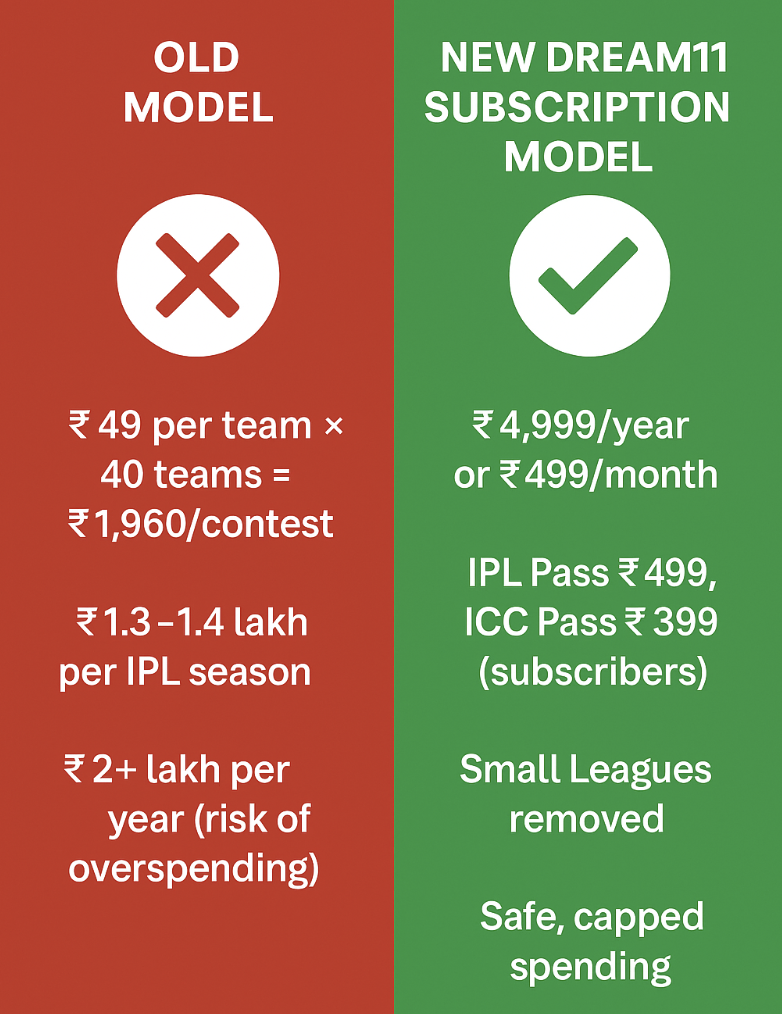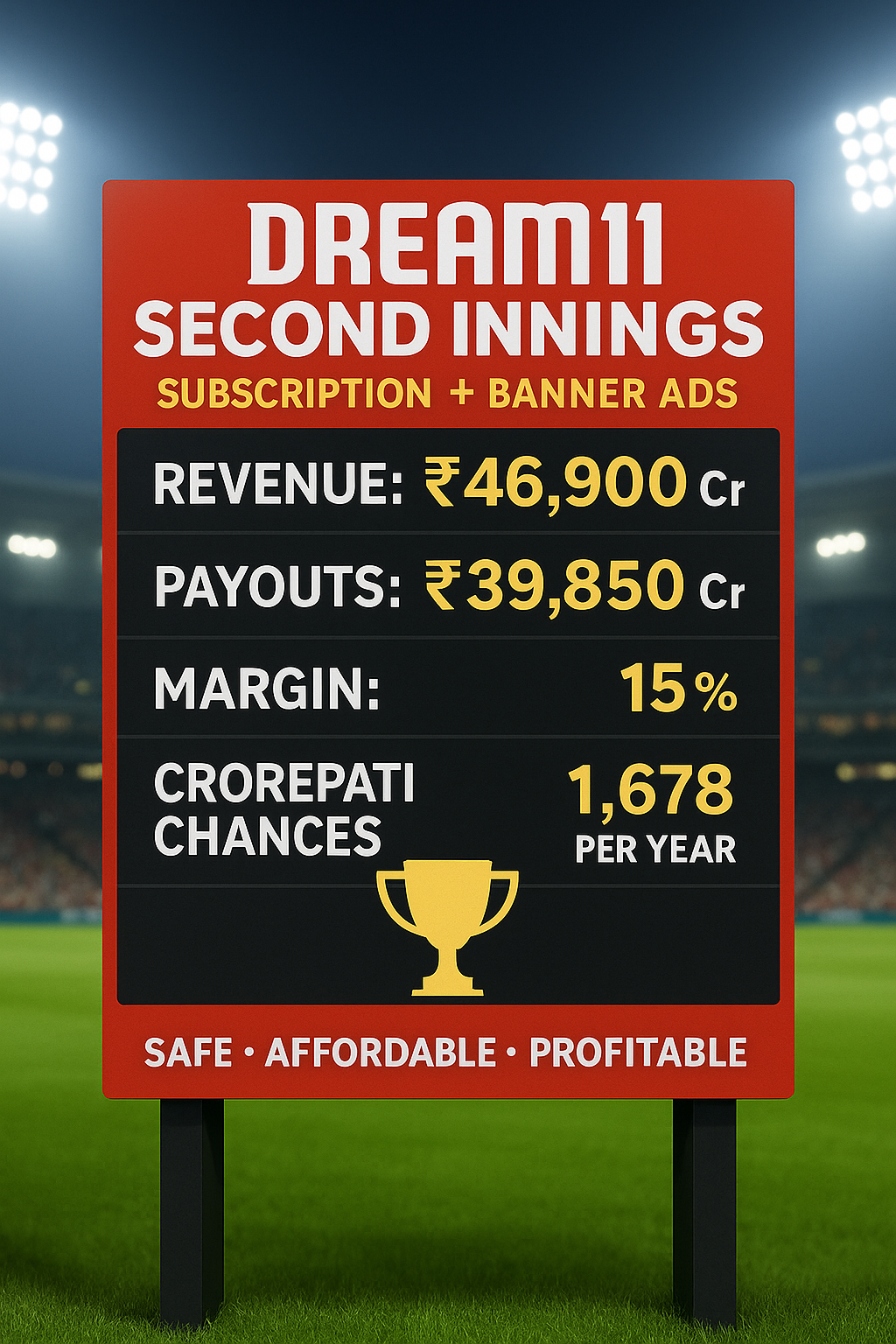Introduction
Dream11 Subscription Model is emerging as the most practical idea for the platform after the Promotion and Regulation of Online Gaming Act 2025 banned real-money entry fees. The Dream11 future business model needs to evolve beyond deposits, and the best way forward is a combination of subscription plans, banner ads, and brand sponsorships. With over 21 crore users, the fantasy sports market in India has the scale to make this approach profitable and sustainable.This is not the official roadmap but a strategic suggestion for the future business model — one that allows a compliant, user-friendly, and highly profitable second innings for fantasy sports in India.

Table of Contents
This is not the official roadmap but a strategic suggestion for the Dream11 future business model — one that allows a compliant, user-friendly, and highly profitable second innings for fantasy sports in India.
Moving Beyond the Watch Ads Model in Dream11 Future Business Model
The earlier concept of making users watch five ads per team entry was flawed. A fantasy player creating 10 teams would need to watch 50 ads before joining a Grand League. This would frustrate users and reduce engagement.
The subscription model supported by banner ads removes this friction, letting contests remain fast, exciting, and rewarding. More details of the earlier ads-based model are discussed in the Dream11 free entry Grand League model.
Subscription Model: The Backbone of Future Revenue
Subscriptions bring predictable recurring revenue. Even if a small percentage of Dream11’s 21 crore users adopt it, the numbers are massive:
- Annual Subscription Plan (₹4,999/year): Includes Grand League entries and discounted IPL pass ₹499 and ICC pass ₹399 (vs ₹1,499 and ₹999 for non-subscribers). ~₹12,383 crore revenue.
- Monthly Subscription Plan (₹499/month): Same discounts as above. ~₹28,921 crore revenue.
- Event-Only Users (non-subscribers): IPL ₹1,499, ICC ₹999. ~₹5,246 crore revenue.
👉 Total Dream11 subscription model revenue ≈ ₹46,550 crore annually.
Banner Ads in Future Business Model
While the subscription model drives bulk revenue, banner ads add extra profit. Users switch between team creation, stats, and contest join pages, generating 5–8 banner impressions each.
- Revenue per contest from banner ads: ₹1.15–2.1 crore
- Annual banner ad revenue: ~₹260–470 crore
This ensures advertisers stay invested in fantasy sports in India, while Dream11 gets supplementary income.
Brand Sponsorship in the Dream11 Future Business Model
Alongside subscriptions and banner ads, brand sponsorships create another layer of financial strength. Major brands like TATA, Pepsi, Coca-Cola, BYJU’S, and fintech companies already spend heavily on cricket sponsorships. Dream11 can leverage this model in multiple ways:
- Event Partnerships: Sponsoring marquee IPL and ICC contests, reducing Dream11’s direct prize pool liability.
- In-App Branding: Logos and product placements inside contest pages or prize pool announcements.
- Exclusive Contest Naming: “TATA Grand League” or “Pepsi Power Play Contest” as headline events.
- User Engagement: Bonus passes through branded QR scans or streak challenges tied to sponsor products.
This could add ₹2–3 crore per contest during marquee tournaments, and several hundred crores annually. More importantly, sponsorship transforms Dream11 from a fantasy app into a sports entertainment ecosystem where fans, brands, and broadcasters all benefit.
Importantly, this sponsorship revenue is a bonus layer, not the backbone. Even without it, the Dream11 subscription model and banner ads make the business sustainable. Sponsorships simply provide upside potential during premium events.
How Sponsorship Already Works in Indian Cricket
To understand how brand tie-ups could power the Dream11 future business model, we can look at existing cricket sponsorship deals.
- The IPL has seen TATA Group commit ₹670 crore for title sponsorship.
- Companies like Pepsi, Vivo, and Dream11 itself have previously held multi-year title sponsorships for the IPL, investing hundreds of crores.
- Coca-Cola and other FMCG giants frequently run limited-time campaigns tied to ICC tournaments.
If brands are willing to pay this much for on-ground visibility, the opportunity for digital sponsorship inside the Dream11 app is equally compelling. Unlike static stadium banners, Dream11’s platform offers direct user engagement— sponsors can tie rewards, passes, or streaks directly to product sales. This makes brand spending measurable and far more impactful.
👉 By borrowing from this proven IPL model, Dream11 can strengthen its subscription-first structure with trusted consumer brand partnerships.
Affordability for Users
A common concern is whether subscription model pricing (₹4,999 annually or ₹499 monthly) is too high. Compared to the old real-money entry system, it is far cheaper and safer.
- Old model: ₹49 per team × 40 teams = ₹1,960 per contest. Over an IPL season, heavy users spent ₹1.3–1.4 lakh, sometimes over ₹2 lakh annually including other sports.
- New model: ₹4,999 annually (or ₹499 monthly) + IPL pass ₹499 and ICC pass ₹399.
- Small Leagues are removed, reducing overspending risk.
👉 Instead of unpredictable six-figure annual spends, users now pay ₹5,000–10,000 annually in a controlled, subscription-style model — just like OTT services.

Dream11 Grand League Prize Pool Structure
To make contests attractive, the Dream11 Grand League prize pool has been optimized for sustainability:
| Rank | Winners | Prize (₹) | Total (₹) | Total (Cr) |
|---|---|---|---|---|
| 1 | 1 | 3,00,00,000 | 3,00,00,000 | 3.00 |
| 2 | 1 | 1,00,00,000 | 1,00,00,000 | 1.00 |
| 3 | 1 | 50,00,000 | 50,00,000 | 0.50 |
| 4–10 | 7 | 10,00,000 | 70,00,000 | 0.70 |
| 11–100 | 90 | 25,000 | 22,50,000 | 0.225 |
| 101–1,000 | 900 | 2,000 | 18,00,000 | 0.18 |
| 1,001–10,000 | 9,000 | 500 | 45,00,000 | 0.45 |
| 10,001–50,000 | 40,000 | 100 | 40,00,000 | 0.40 |
| 50,001–35,00,000 | 34,90,000 | 50 | 17,45,00,000 | 17.45 |
| Total Winners | 35,00,000 (70%) | — | — | 23.75 cr |
- 70% winners per contest
- ₹50 minimum prize
- ₹3 crore top prize
- Payout ≈ ₹23.75 cr per contest against revenue ~₹27.95 cr → 15% Dream11 margin

Crorepati Chances
Every flagship Grand League gives users a shot at becoming a crorepati.
- Matches/year: ~839
- Contests/match: 2 (each capped at 50 lakh teams, not one mega contest of 1 crore)
- Total contests/year: ~1,678
- Top prize per contest: ₹3 crore
👉 That means 1,678 crorepati opportunities per year.
Team cap rule for fairness
- Max 10 teams per match per user.
- Teams can go into one contest or be split across both, but total stays at 10.
- No duplication of the same team across contests.
- This ensures fair participation for all subscribers.
In total, one user has 8,390 team opportunities annually under the Dream11 subscription model.
User Retention Benefits of the Dream11 Subscription Model
One of the biggest advantages of the Dream11 Subscription Model is its ability to retain users. In the pre-ban era, many users dropped off after losing heavily in Small Leagues or after multiple contests without a win. With no spending cap, disappointment often turned into churn.
The subscription system changes this dynamic completely. Instead of worrying about daily or seasonal deposits, users know their costs are fixed — ₹4,999 per year or ₹499 per month, plus small IPL and ICC passes. This creates an OTT-style experience, where users keep returning to play because the cost is already covered.
- Lower churn: Users don’t quit after heavy losses, since their maximum cost is already locked.
- Higher engagement: Subscribers are more likely to play every match, ensuring continuous activity across cricket, kabaddi, and football.
- Improved trust: With a clear cap, users feel protected against overspending, which builds long-term loyalty.
From a business perspective, this is invaluable. Predictable revenue from subscriptions gives Dream11 the financial base to run large Grand League contests while banner ads add extra revenue. This dual stream strengthens the Dream11 future business model by combining stability with growth potential.
Comparison with Other Subscription Models
Globally, subscription-based models are proven to work across industries:
- Entertainment: Netflix and Disney+ Hotstar charge more than Dream11’s plan annually but only provide content, not prize-winning opportunities.
- Learning: Byju’s and Unacademy rely on subscription fees for predictable income, though users only gain skills, not financial rewards.
- Gaming: PlayStation Plus and Xbox Game Pass cost more than Dream11’s annual fee, offering game access but no monetary returns.
👉 In comparison, the Dream11 Subscription Model is cheaper than OTT and gaming subscriptions and adds the excitement of real skill-based winnings. This makes it a compelling offer in the Indian market, where affordability and reward potential drive adoption.
Impact on Broadcasters and Indian Sports Ecosystem
Fantasy sports don’t just benefit platforms — they fuel the entire sports ecosystem.
- Broadcasters: Star Sports, JioCinema, and Sony benefit from higher TRPs because fantasy players watch every ball closely.
- Sponsors: Brands tied to contests get premium engagement, far beyond traditional TV ads.
- Leagues: Domestic cricket (TNPL, Ranji), kabaddi (PKL), and football (ISL) gain more fan traction through fantasy integration.
By aligning with this model, broadcasters could even co-sponsor Dream11’s prize pools, since they directly profit from the increased viewership and ad sales generated by fantasy sports.
User Journey Under the Dream11 Subscription Model
To visualize the experience, here’s a typical day in the life of a Dream11 subscriber:
- Login: A user logs in with an active subscription.
- Team Creation: They create up to 10 teams for the day’s matches.
- Contest Choice: They join Contest A or split teams between Contest A and B (max 10 combined).
- Sponsorship Exposure: Contest banners show “TATA Grand League” or “Pepsi Power Play Contest.”
- Match Engagement: The subscriber follows the match closely, cheering for fantasy points.
- Results: With 70% winners, they likely win at least small amounts regularly.
👉 This predictable, rewarding loop ensures users stay active and engaged throughout the year.
Annual Revenue vs Prize Payouts in Future Business Model
- Annual revenue: ~₹46,900 crore
- Annual sponsorship boost (bonus): ~₹400–600 crore
- Total annual revenue: ~₹47,300 crore (approx.)
- Annual prize payouts: ~₹39,850 crore
- Gross profit: ~₹7,450 crore
- Margin: ~15–16%
Industry studies such as media and entertainment industry reports show that this payout-to-revenue ratio is both sustainable and user-friendly.
Global Expansion Potential of the Dream11 Future Business Model
The Dream11 Future Business Model is not limited to India. Subscription models are already proven globally in industries like streaming, gaming, and SaaS. Fantasy sports can follow the same path.
Dream11 has previously sponsored major tournaments like the IPL and ICC World Cup, but with the Promotion and Regulation of Online Gaming Act 2025 restricting real-money games, expansion needs to align with new structures. A subscription-first approach makes it possible to expand into:
- Emerging cricket nations like Afghanistan, Ireland, Zimbabwe, and women’s cricket leagues.
- Other sports such as kabaddi, football, and basketball.
- International markets like the UK, US, and Middle East with large South Asian diaspora.
By aligning with global OTT trends, Dream11 can evolve into a global sports engagement platform. For deeper projections, see Dream11’s global revenue model for 2025 to 2028.
Why the Subscription Model Builds Trust Among Users
One of the most important aspects of the Dream11 Subscription Model is user trust. In the pre-ban era, many fantasy players were skeptical because there was no spending limit. A single IPL season could drain more than ₹1 lakh for heavy users, creating financial stress and negative perceptions of fantasy sports in India.
The subscription approach solves this problem:
- Fixed Costs = Transparency
With ₹4,999 per year or ₹499 per month, users know upfront how much they will spend. There are no hidden deposits, no surprises. - No Small Leagues = No Over-Investment
Eliminating Small Leagues means players are not lured into endless micro-contests that increase risk without meaningful returns. - High Win Ratio = Fairness
By ensuring 70% of participants win something in each Grand League, the model improves satisfaction and reduces disappointment. - Skill-Based Rewards = Legitimacy
Since prizes depend entirely on team selection and match analysis, the game retains its recognition as a skill-based activity — aligning with Supreme Court rulings.
The result is a system where users feel protected, rewarded, and respected. Trust is not just a compliance requirement — it is the foundation of long-term user loyalty and growth for the Dream11 future business model.
Why the Dream11 Subscription Model Works
- ✅ User friendly: No forced ads, instant play
- ✅ Predictable income: Recurring subscriptions
- ✅ Fair play: 70% winners, capped teams
- ✅ Advertiser value: Banner ads supplement income
- ✅ Sponsorship boost: Brands like TATA, Pepsi, Coca-Cola add extra revenue
- ✅ Financially sustainable: 15–16% margin retained
- ✅ Engaging: 1,678 crorepati chances every year
Fantasy sports thus evolves from a risky spending habit into a subscription-based entertainment platform — engaging, rewarding, and financially safer. a risky spending habit into a subscription-based entertainment platform — engaging, rewarding, and financially safer.

Global Expansion Potential of the Dream11 Future Business Model
The Dream11 Future Business Model is not limited to India. Subscription models are already proven globally in industries like streaming, gaming, and SaaS. Fantasy sports can follow the same path.
Dream11 has previously sponsored major tournaments like the IPL and ICC World Cup, but with the Promotion and Regulation of Online Gaming Act 2025 restricting real-money games, expansion needs to align with new structures. A subscription-first approach makes it possible to expand into:
- Emerging cricket nations: Afghanistan, Ireland, Zimbabwe, and women’s cricket leagues are all seeing rising fan engagement. Subscription access ensures these contests stay popular.
- Other sports: Kabaddi, football (ISL), and even basketball leagues can be integrated under the same subscription.
- International markets: South Asian diaspora in the UK, US, and Middle East form a natural audience for fantasy cricket, and a compliant subscription model can reach them too.
By aligning with global OTT trends, Dream11 can evolve from a fantasy sports app into a global sports engagement platform. This would also strengthen its case for partnerships with broadcasters and advertisers worldwide. For deeper projections, see the analysis on Dream11’s global revenue model for 2025 to 2028.
Conclusion: Dream11 Future Business Model After the Act
The Promotion and Regulation of Online Gaming Act 2025 may have ended Dream11’s original innings, but it opened the door for reinvention. A Dream11 subscription model powered by banner ads and sponsorships ensures compliance, profitability, affordability, and continuous user excitement.
Instead of unpredictable six-figure spends, users now have a capped, responsible, and engaging experience with thousands of opportunities to win.
👉 These are strategic suggestions, not official Dream11 plans. But if platforms adopt this vision, fantasy sports in India can thrive in its second innings, building on Dream11’s global revenue projections from 2025 to 2028.
FAQ Section
What is the Dream11 subscription model?
The Dream11 subscription model is a proposed future business model where users pay an annual or monthly fee instead of real-money entry fees, ensuring safe and responsible play.
How does the Dream11 future business model generate revenue?
Dream11 revenue under the new model would come from subscription fees, discounted IPL and ICC passes, and banner ad income.
Is the Dream11 subscription model affordable for users?
Yes, compared to the old system where heavy users could spend ₹1–2 lakh annually, the subscription model caps costs at ₹4,999 annually or ₹499 monthly, plus small passes.
How many chances do users get to win ₹3 crore in Dream11?
On average, there are ~1,678 contests per year, giving users 1,678 opportunities to win ₹3 crore under the subscription model.
How is the Dream11 future business model compliant with the Online Gaming Act 2025?
Since there are no deposits or real-money entry fees, the model avoids gambling elements and remains compliant with the Promotion and Regulation of Online Gaming Act 2025.
Is the Dream11 Subscription Model allowed under the Online Gaming Act 2025?
Yes. The Dream11 Subscription Model is compliant with the Promotion and Regulation of Online Gaming Act 2025because it is based on subscriptions and not real-money deposits or wagers. Under the Act, “online money games” are banned, but “online social games” — which may include subscriptions or access fees — are allowed. Since there is no wagering involved and prizes are based on skill, the subscription model qualifies as a legal, compliant structure.
How do brand sponsorships boost the Dream11 future business model?
Brand sponsorships add financial strength without depending on user deposits. By tying contests to names like TATA or Pepsi, Dream11 reduces its own prize pool liability while increasing fan excitement and brand visibility.
Can the Dream11 Subscription Model expand to sports beyond cricket?
Yes. The model can easily extend to kabaddi, football (ISL), and even basketball leagues, giving users more value for their subscription